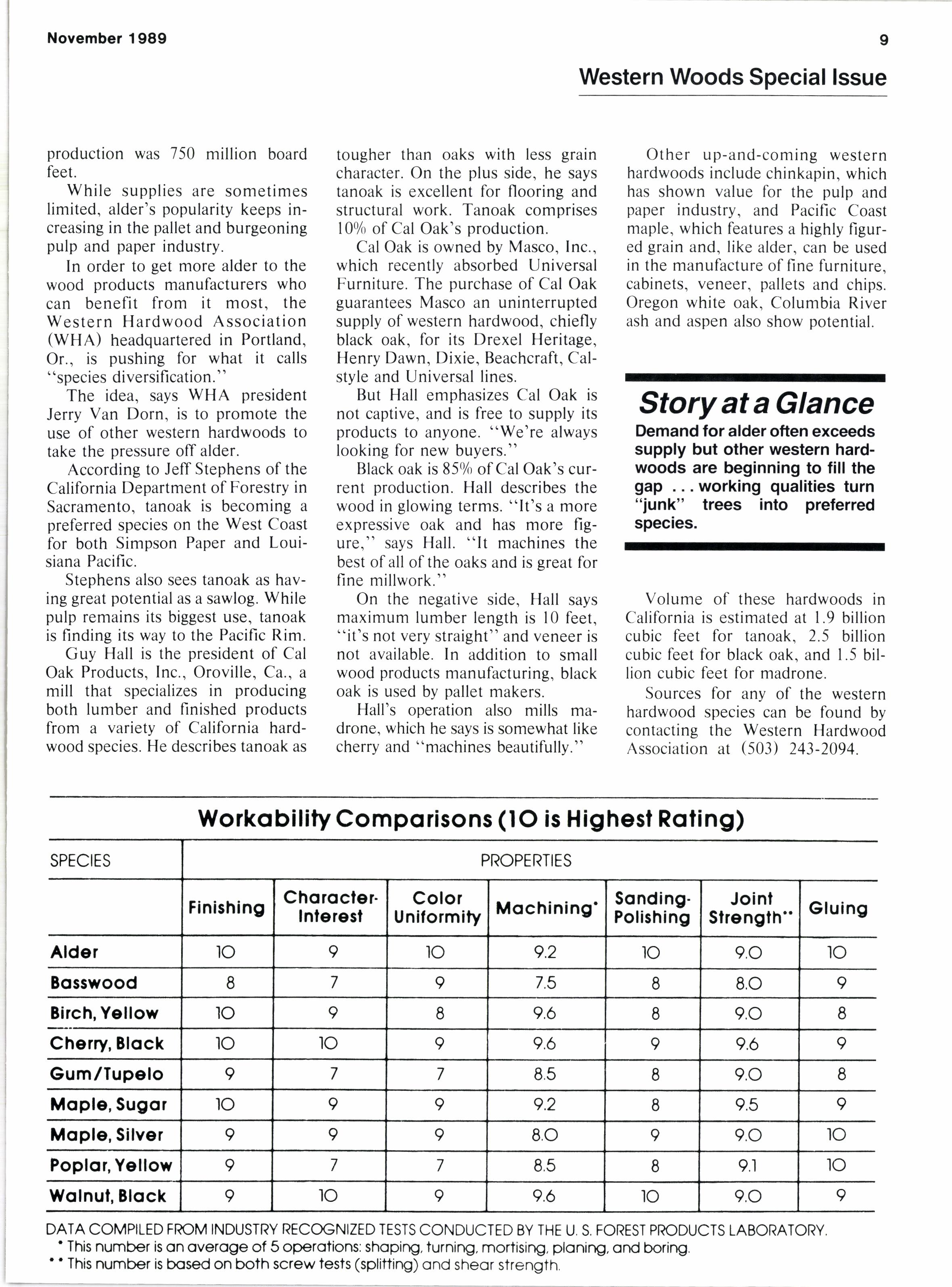
2 minute read
Western hardwoods: a growing force
By Dave Sweitzer Secretary/Manager Western llardwood Association
challenge the western hardwood industry.
For years western alder has been the crown prince of western hard- woods, but with demand for alder exceeding the current restricted log supply, other western hardwoods are making their way into the royal family.
Those woods, primarily Pacific Coast maple, Oregon white oak, California black oak. tanoak, madrone and chinkapin, all feature unique characteristics suitable for machining and pallet and paper products manufacturing.
Alder's workability characteristics are due to it being one of the "softer" hardwoods. Its consistent, light straight grain makes it easily finished to look like many other, more-diffi cult-to-mill hardwoods.
Strict grading standards and the availability of alder veneer have added to the wood's desirability for manufacturing a large variety of products, ranging from exposed wood furniture to upholstered furniture frames, from cabinets to toilet seats, and even chopsticks.
It's estimated that Northwest lorests currently hold 22 billion board feet of merchantable alder. Unfortunately, much of it is located in protected riparian (stream side) areas and in contested old-growth federal forest lands. 1988 alder log production was 750 million board feet.
While supplies are sometimes limited, alder's popularity keeps increasing in the pallet and burgeoning pulp and paper industry.
In order to get more alder to the wood products manufacturers who can benefit from it most, the Western Hardwood Association (WHA) headquartered in Portland, Or., is pushing for what it calls "species diversification."
The idea, says WHA president Jerry Van Dorn, is to promote the use of other western hardwoods to take the pressure off alder.
According to Jeff Stephens of the California Department of Forestry in Sacramento, tanoak is becoming a preferred species on the West Coast for both Simpson Paper and Louisiana Pacific.
Stephens also sees tanoak as having great potential as a sawlog. While pulp remains its biggest use, tanoak is finding its way to the Pacific Rim.
Guy Hall is the president of Cal Oak Products. Inc.. Oroville. Ca.. a mill that specializes in producing both lumber and finished products from a variety of California hardwood species. He describes tanoak as
Western Woods Special lssue
tougher than oaks with less grain character. On the plus side, he says tanoak is excellent for flooring and structural work. Tanoak comprises 10% of Cal Oak's production.
CalOak is owned by Masco, Inc., which recently absorbed Universal Furniture. The purchase of Cal Oak guarantees Masco an uninterrupted supply of western hardwood, chiefly black oak, for its Drexel Heritage, Henry Dawn, Dixie, Beachcraft, Calstyle and Universal lines.
But Hall emphasizes Cal Oak is not captive, and is free to supply its products to anyone. "We're always looking for new buyers."
Black oak is 850/o of CalOak's current production. Hall describes the wood in glowing terms. "lt's a more expressive oak and has more figure," says Hall. "lt machines the best ofall ofthe oaks and is great for fine millwork."
On the negative side, Hall says maximum lumber length is l0 feet, "it's not very straight" and veneer is not available. In addition to small wood products manufacturing, black oak is used by pallet makers.
Hall's operation also mills madrone, which he says is somewhat like cherry and "machines beautifully."
Other up-and-coming western hardwoods include chinkapin, which has shown value for the pulp and paper industry, and Pacific Coast maple, which features a highly figured grain and, like alder, can be used in the manufacture of fine furniture, cabinets, veneer, pallets and chips. Oregon white oak, Columbia River ash and aspen also show potential.

Story at a Glance
Demand for alder often exceeds supply but other western hardwoods are beginning to fillthe gap ...working qualities turn "junk" trees into preferred species.
Volume of these hardwoods in California is estimated at 1.9 billion cubic feet for tanoak, 2.5 billion cubic feet for black oak, and 1.5 billion cubic feet for madrone.
Sources for any of the western hardwood species can be found by contacting the Western Hardwood Association at (503) 243-2094.









